Disclaimer: This post may contain Amazon affiliate links. Sudachi earns a small percentage from qualifying purchases at no extra cost to you. See disclaimer for more info.
Featured Comment:
“Made this today with norwegian potato starch (I couldn’t find warabiko or katakuriko), but I think it still turned out wonderful. Just such a great texture, and nice simple flavours. Thank you for sharing this recipe. Will make again.”
– Cathrine
What is Warabi Mochi?
Warabi Mochi (わらび餅) is a type of traditional “wagashi” (Japanese sweet) with a chewy jelly-like texture. It gets its name from its key ingredient, “warabiko” (わらび粉), which is a starch that comes from the rhizome (underground stem) of a type of fern tree called “bracken”. This is why it is sometimes translated as “bracken cake” in English. Since it’s not made from rice flour (mochiko), it’s technically not mochi but it gets its name from its mochi-like jelly texture.
Warabiko is flavorless and the flavor of Warabi Mochi comes purely from sugar, and the powdered toppings and syrups it’s served with. Kinako (soybean powder) is the most popular flavor, but other flavors also exist such as matcha. For added sweetness, it’s common to pour black sugar syrup “kuromitsu” over the top, so I’ve included how to make the syrup in the recipe below!
Warabi Mochi is often served chilled and is typically enjoyed in the summer.
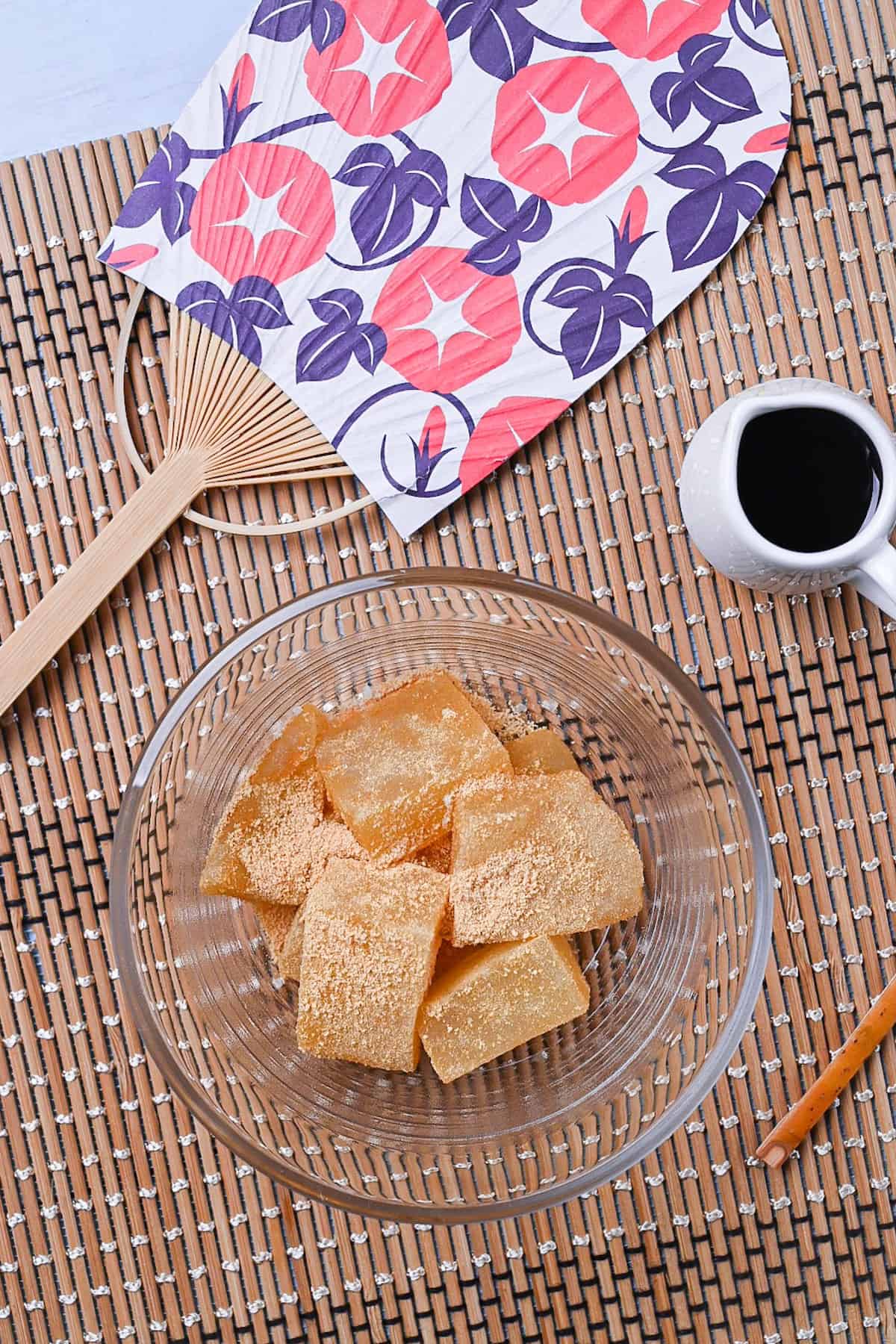
Ingredients
Warabi Mochi only requires a handful of ingredients. For this recipe you will need:
- Warabiko (わらび粉): also known as bracken starch. If you can’t get warabiko, tapioca starch or potato starch can be used instead. See more information below!
- Sugar: Regular white caster sugar is used to sweeten the warabi mochi and kinako powder coating.
- Water: to dissolve the sugar and starch
- Kinako powder (roasted soybean powder): roasted soybean powder is the most common ingredient used to coat warabi mochi. If it’s not accessible to you, you could try ground peanuts for a similar flavor or different flavors such as matcha or cocoa.
- Salt: Used in the coating to enhance the flavor of the kinako.
Warabi Mochi is often drizzled with a thick black sugar syrup we call “kuromitsu” which has kanji characters that mean “black honey” (黒蜜). You can use store-bought or make it at home with the following ingredients:
- Dark Brown Sugar: Muscovado or Okinawan Kokuto (黒糖) for a rich flavor.
- White Sugar: Caster or granulated sugar to balance the richness and add sweetness.
- Water: To dissolve the sugar and make a syrup.
As a final alternative, you can try drizzling Warabi Mochi with other syrups such as honey, maple syrup or dark simple syrup!
Jump to Full Recipe Measurements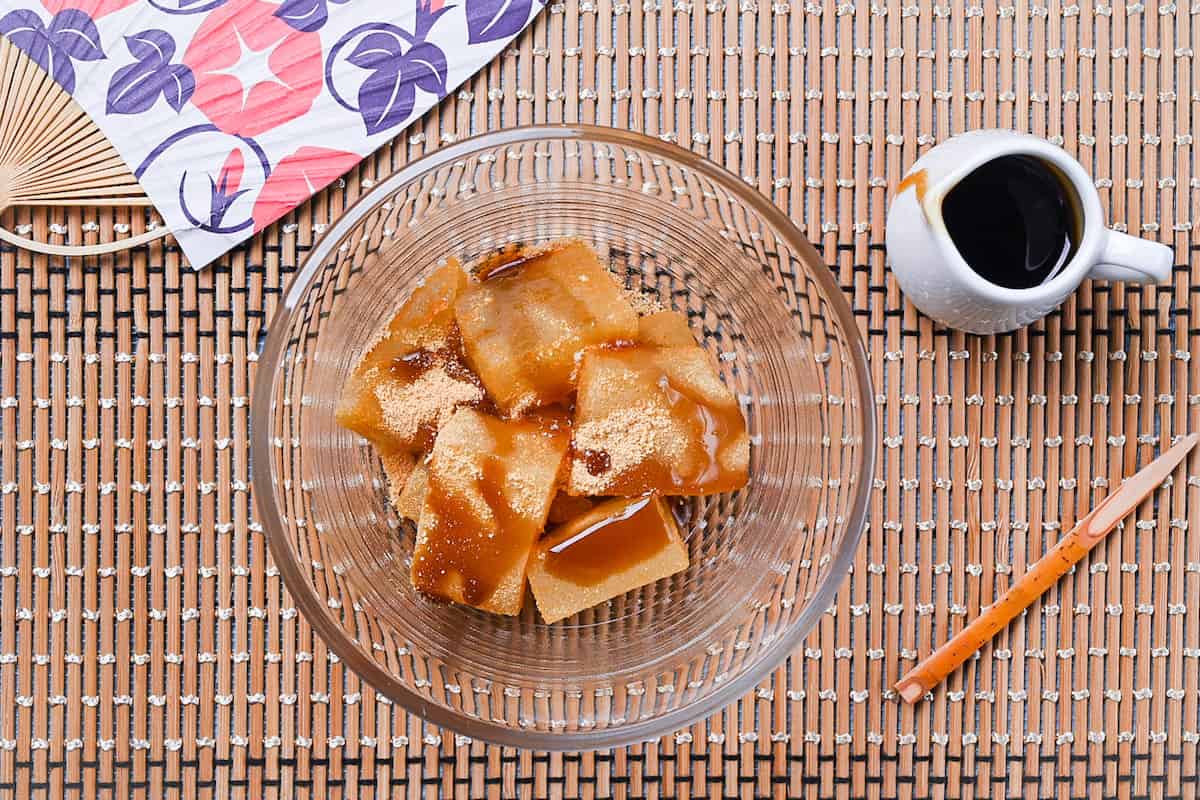
Bracken Starch Substitutes
These days, warabi mochi is not exclusively made with bracken starch, other kinds of starch can also be used. I wanted to see how different kinds of starch affect the taste and texture of warabi mochi, so here are my findings!
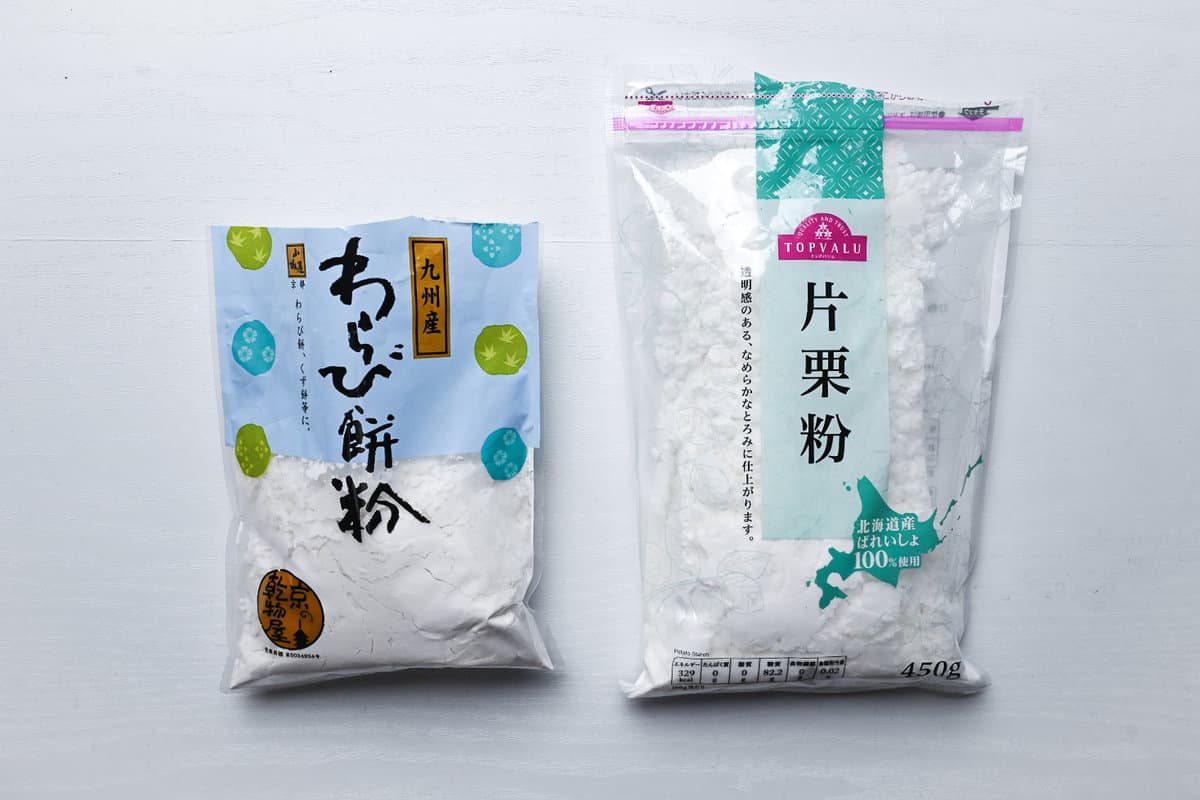
Potato Starch (Katakuriko)
Katakuriko (片栗粉) is the Japanese name for “potato starch”, an extremely common ingredient in Japanese cooking. We often use it as a coating for deep fried foods like karaage and tempura, or to thicken soups and sauces. Naturally, katakuriko is a staple ingredient in Japanese kitchens, and making Warabi Mochi with potato starch is actually the most common substitute ingredient! (You can purchase it here on Amazon.)
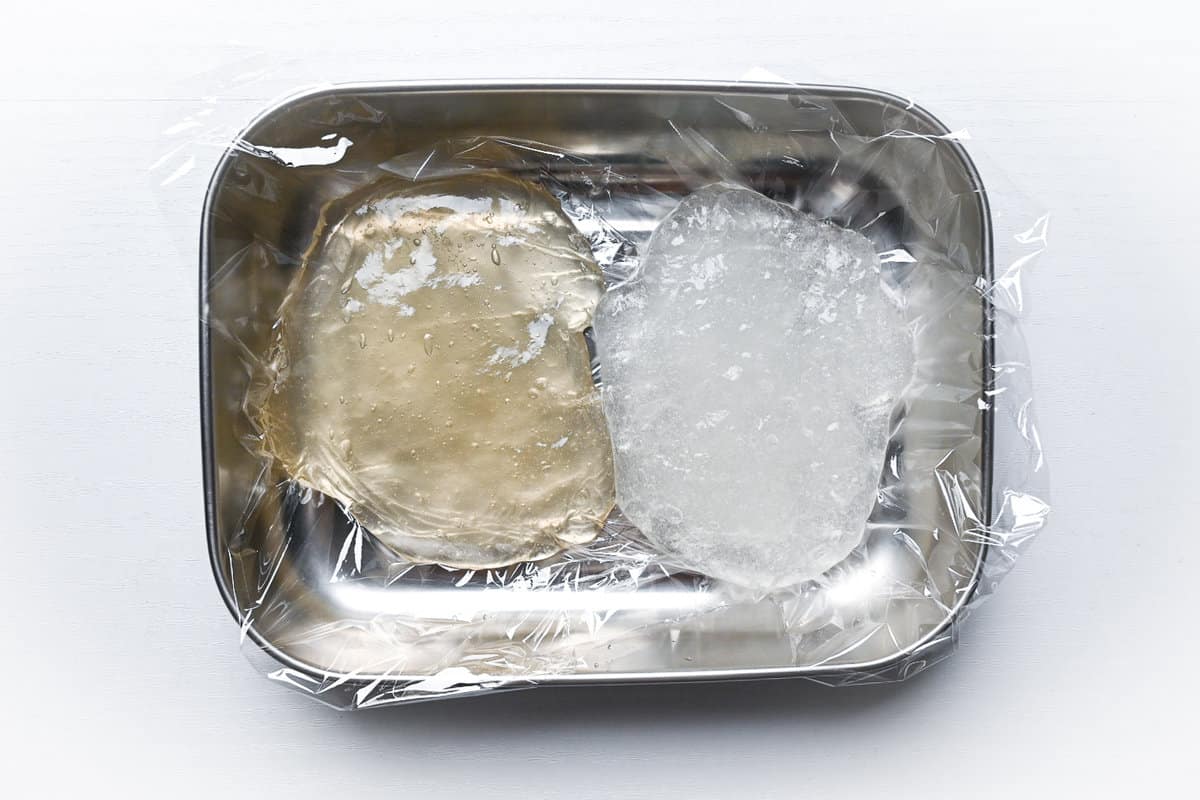
As you can see from the picture above, the bracken starch produced a slightly yellow-looking Warabi Mochi whereas the potato starch is white. In terms of texture, the Warabi Mochi made from bracken starch was very soft while the one made from potato starch was firmer.
| Warabiko | Katakuriko |
|---|---|
| Slightly yellow colour | Clear / white-ish color |
| Soft texture | Slightly firmer |
| Hard to find | Accessible |
| A little expensive | Cheaper |
| Maintains a good texture | Texture deteriorates quickly |
I actually preferred the texture of the potato starch version on day one, but by day two it had began to harden. One the other hand, the one made with warabiko actually improved in texture the next day. Based on this experiment, I’d say that both ingredients are good, but the one made with potato starch should be eaten the same day for the best texture.
Katakuriko (potato starch) works well when eaten the same day.
Cornstarch
When I was living in England, I noticed that the most accessible kind of starch you can buy in most supermarkets is cornstarch (also known as cornflour). Cornstarch is sometimes used as a substitute for potato starch so I decided to try it out!
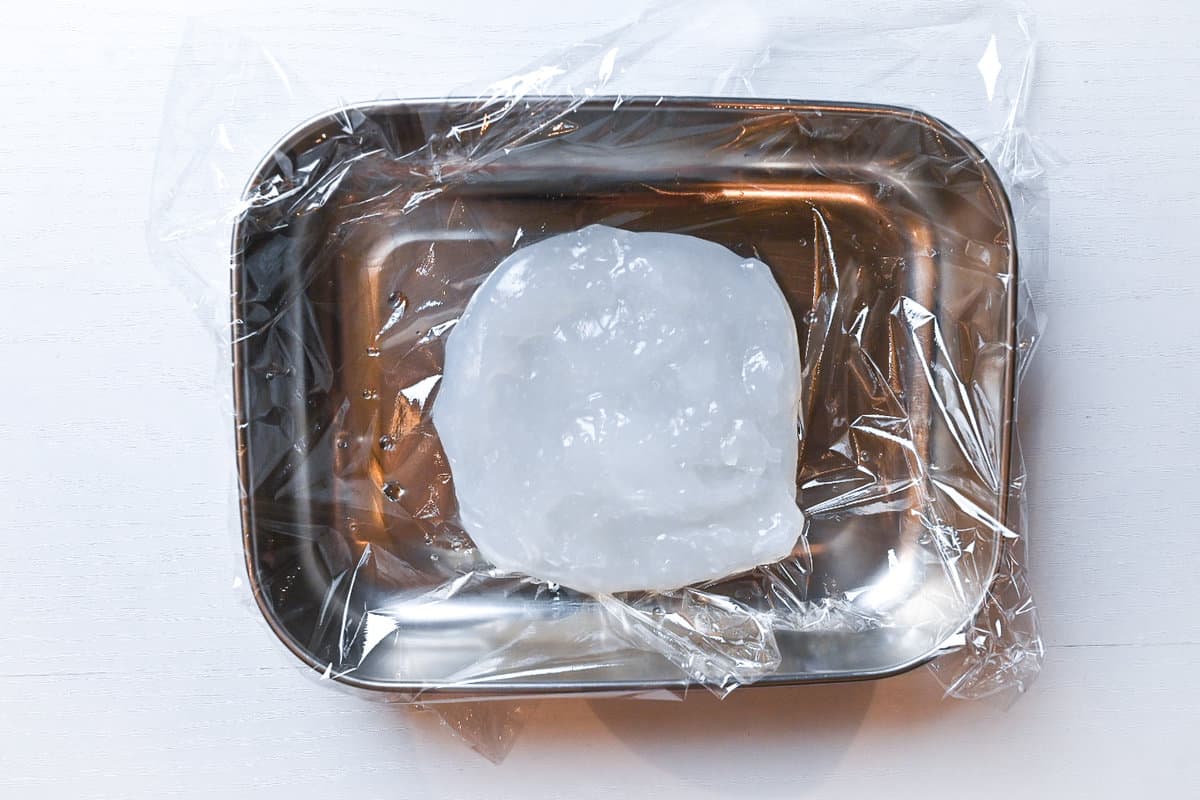
While I was heating the mixture, I found it became quite smooth and almost like a paste. It is also white and quite opaque compared to bracken starch and potato starch. The texture was also less sticky.
Once cut, I tried to coat it in kinako powder. It didn’t stick well so the layer of kinako was quite thin. In terms of texture while eating, it was soft and smooth like gelatine but also felt a little paste-y/powdery and didn’t have the chewiness that I look for in Warabi Mochi.
Powdery and hard, do not recommend.
Tapioca Starch
Tapioca starch comes from the root of the cassava plant and is used to make the boba “pearls” in tapioca drinks. Because it’s a root starch like bracken starch, I thought maybe they would produce similar results. Here is what I found.
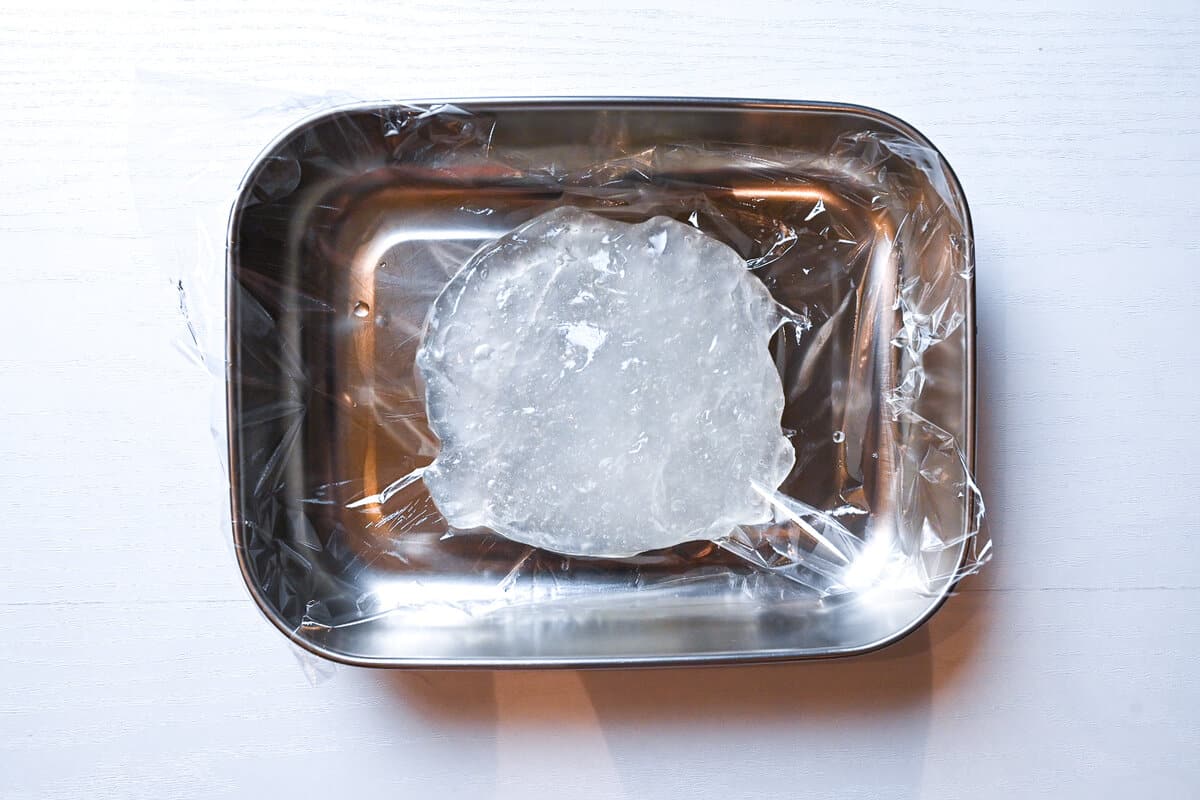
The color is whiter than bracken starch, but in terms of texture, it’s extremely close. Soft with a slightly chewy texture. Both on day one and day two, I couldn’t feel any difference between Warabi Mochi made with bracken starch and tapioca starch. I highly recommend this substitute!
Soft and chewy, closest like-ness to Warabi Mochi made with bracken starch. (Best substitute in my opinion!)
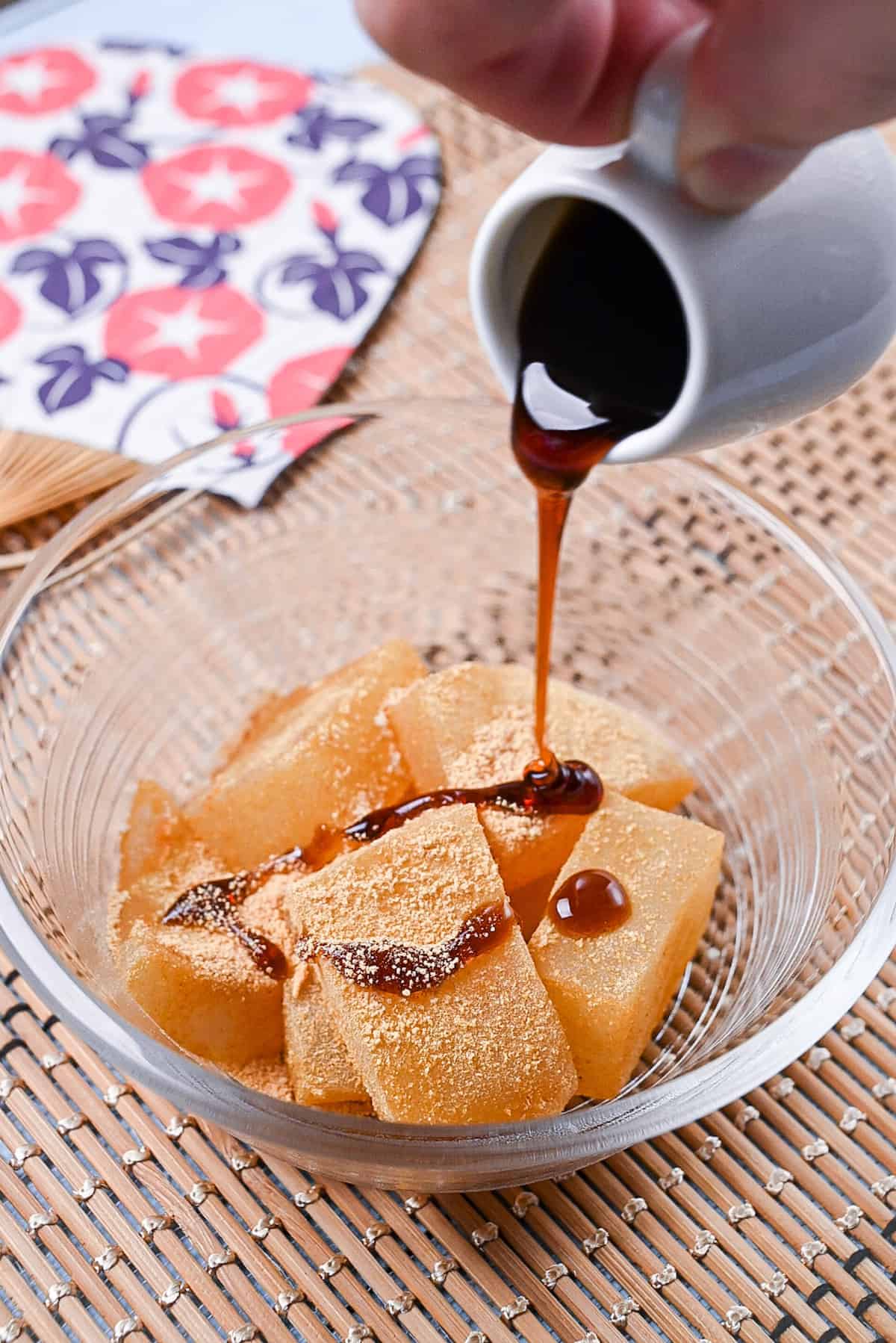
Visual Walkthrough & Tips
Here are my step-by-step instructions for how to make Warabi Mochi at home. For ingredient quantities and simplified instructions, scroll down for the Printable Recipe Card below.
If you prefer to watch the process in action, check out my YouTube video of this recipe for a complete visual walkthrough!

Warabi Mochi is actually not too sticky or unmanageable, but for easy removal and clean-up, I recommend lining a container with plastic wrap sprinkled with a small amount of water.
I recommend using a wide airtight container such as a lunchbox that has a lid. This will help prevent the Warabi Mochi from drying out while it’s cooling.
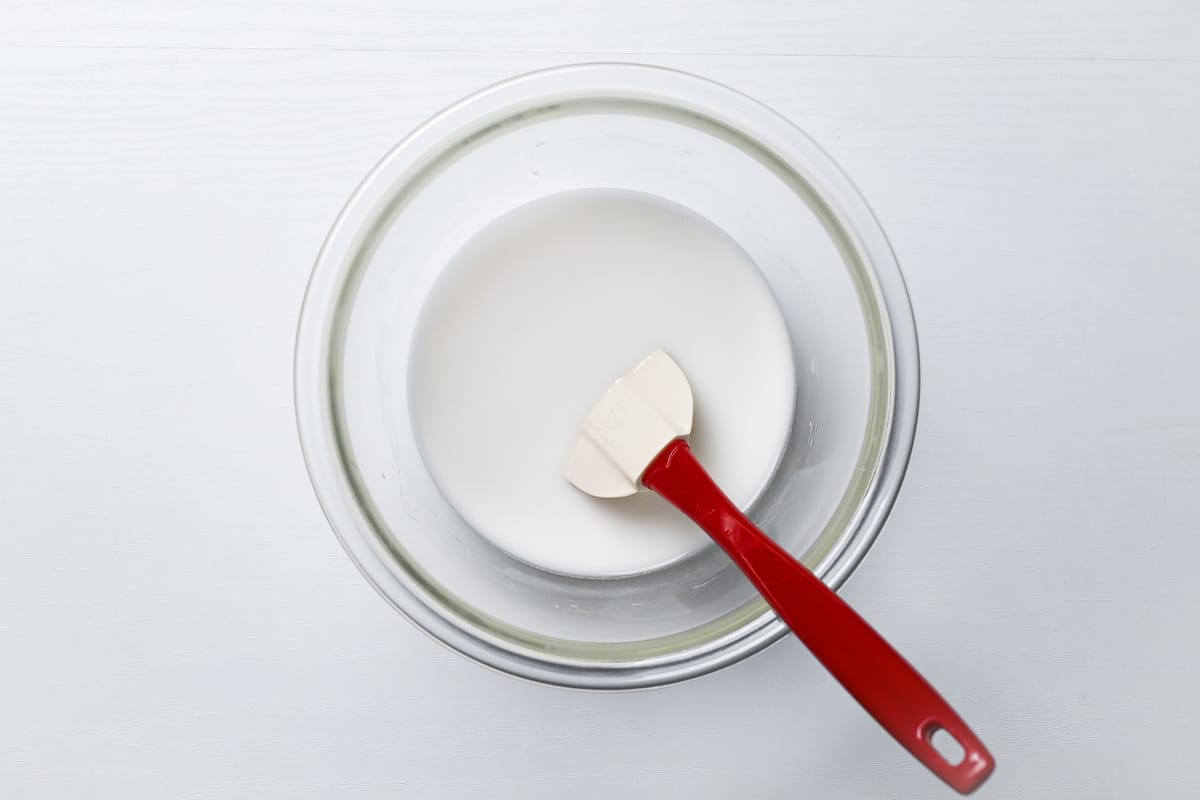
Add the bracken starch (or alternative), sugar, and water to a bowl.
Starch is very fine so there’s no need to whisk it. In fact, mixing with a spatula is preferred because then you can scrape the sides and bottom of the bowl to make sure none of the starch has sunk to the bottom.
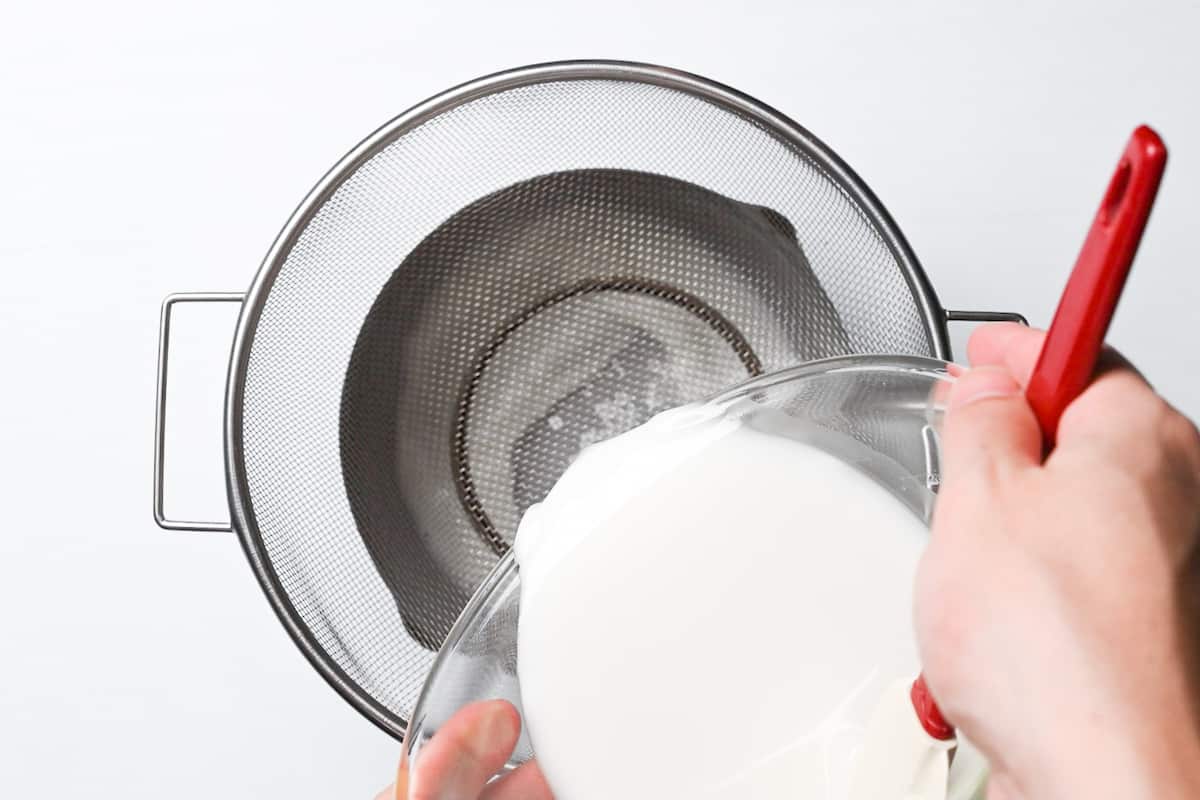
Next, place a sieve over a saucepan and pour the mixture through. This will break up any lumps of sugar or starch resulting in a flawlessly smooth warabi mochi mixture! This will also help it cook more evenly.
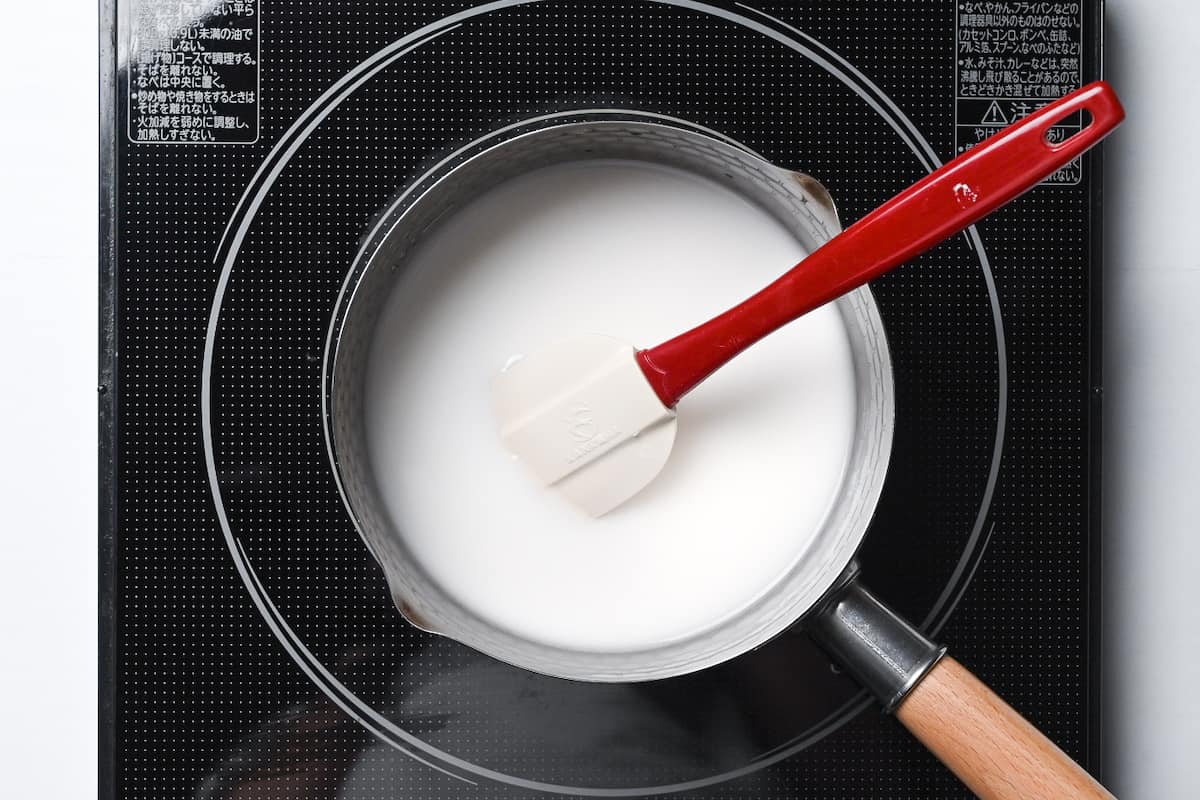
Place the pan on the stove and heat on medium while stirring continuously
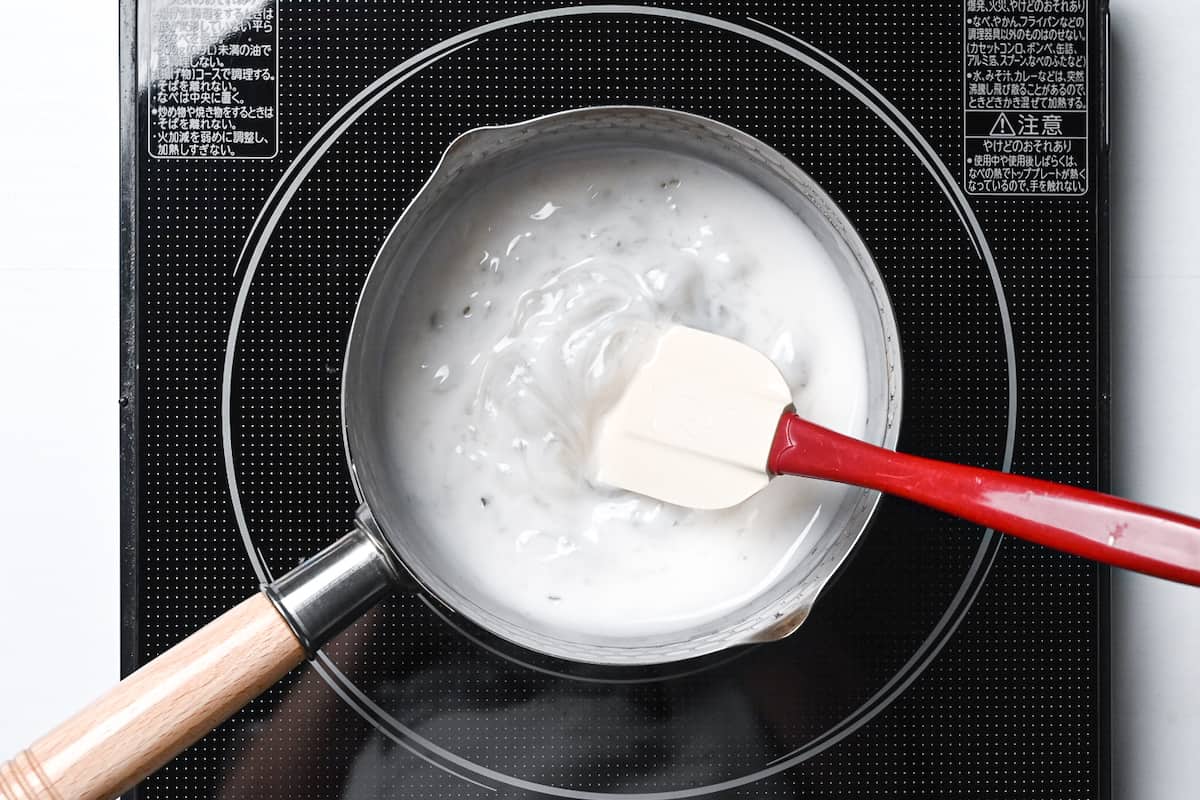
Once it starts to thicken, lower the heat to low/medium-low and continue stirring.
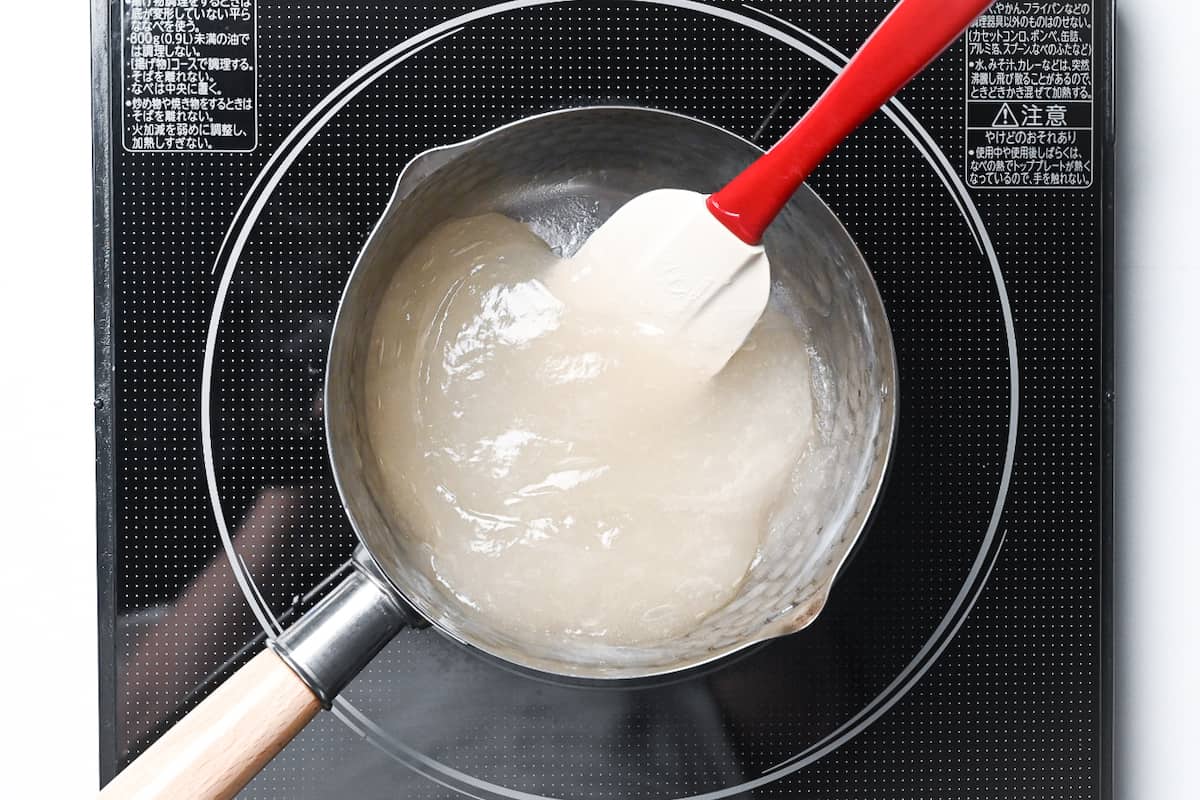
By using low or medium-low heat, you will be able to control the thickness of your warabi mochi with ease. Once the mixture begins to thicken, you won’t believe how quickly it will form a jelly-like ball. There will also be some sticky remains on the bottom of the pan which tend to catch if the heat is too high, so keep it low!
The warabi mochi is fully cooked once all the white liquid has gone and you’re left with a translucent jelly-like ball.
For more control, better texture, and less chance of burning, keep the temperature of your stove on low or medium-low.
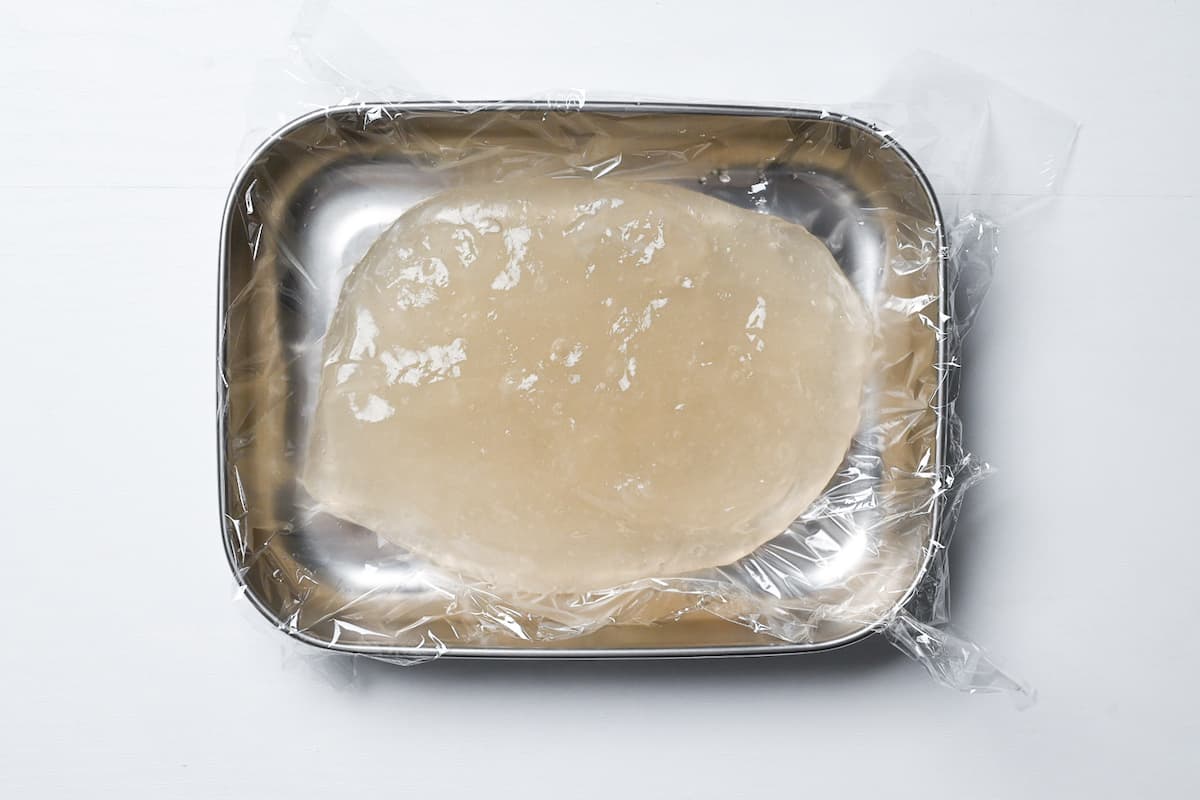
Transfer the Warabi Mochi to your lined container and leave it to cool for about 10 minutes.
It’s okay to leave it out of the fridge because it doesn’t contain perishable ingredients, however, it’s best served chilled so I recommend putting it in the fridge for 30 minutes to 1 hour before eating.
You can also use a spatula sprinkled with water to smooth out the top for a neater finish.
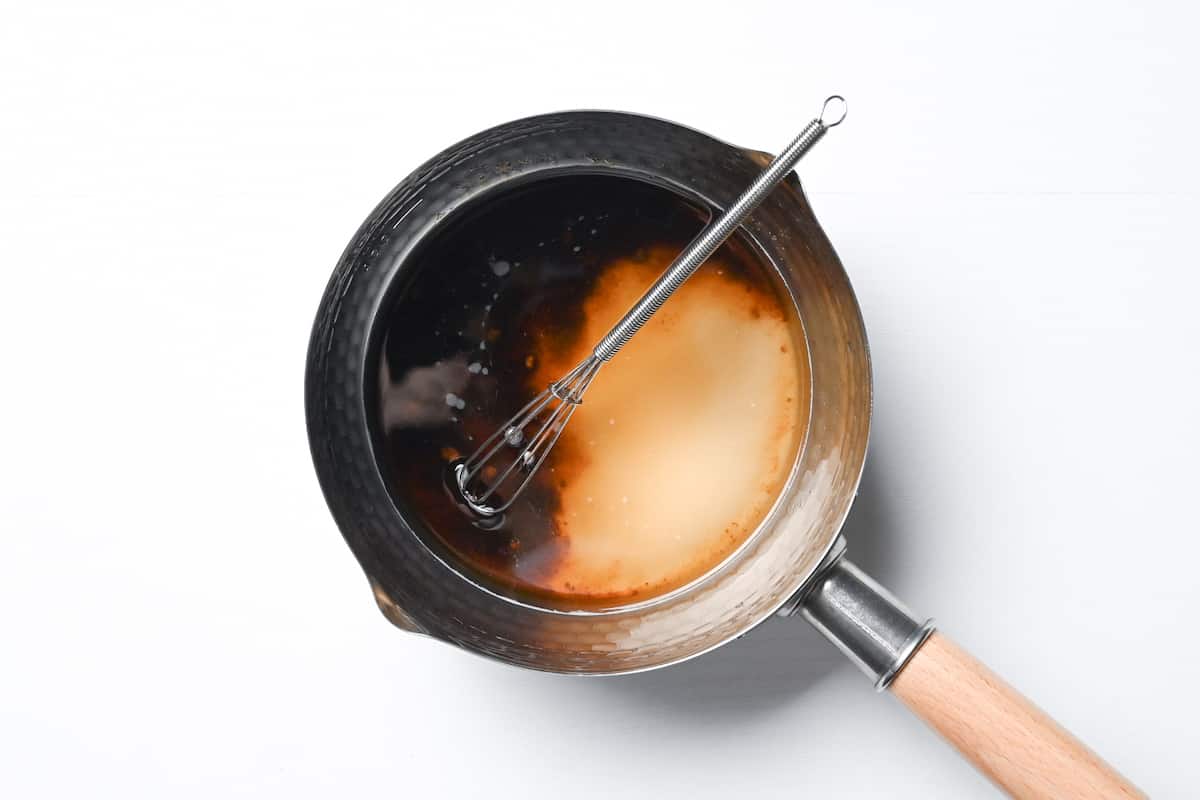
While the Warabi Mochi is chilling, you can make the homemade kuromitsu syrup. Simply mix dark brown sugar (Okinawan kurozato/kokuto or dark muscovado), caster sugar and water in a small sauce pan.
Once it’s mixed, place it on the stove and bring it to a boil over medium heat. (Continue to stir while it’s heating to break up any stubborn lumps of sugar.)
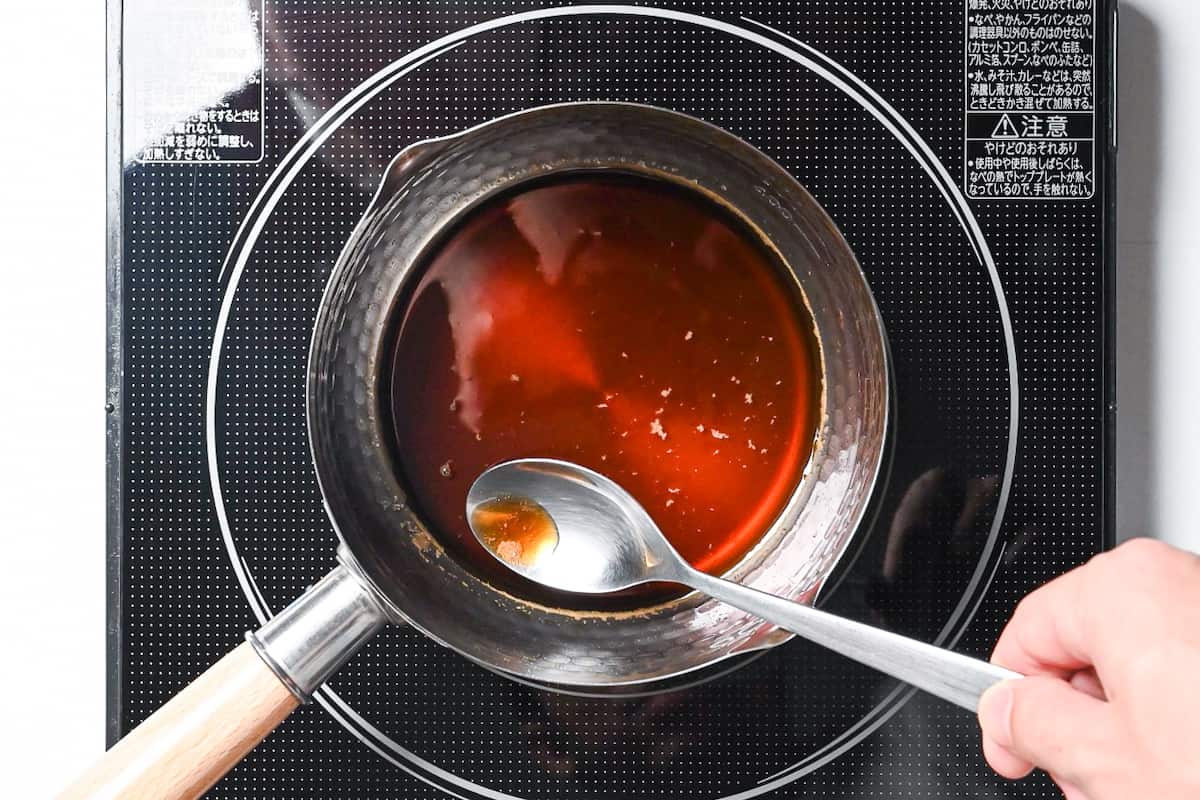
Once it starts to boil, stop stirring and lower the heat to a simmer. Allow the syrup to simmer for 1-2 minutes and scoop out any foam that appears around the edges.
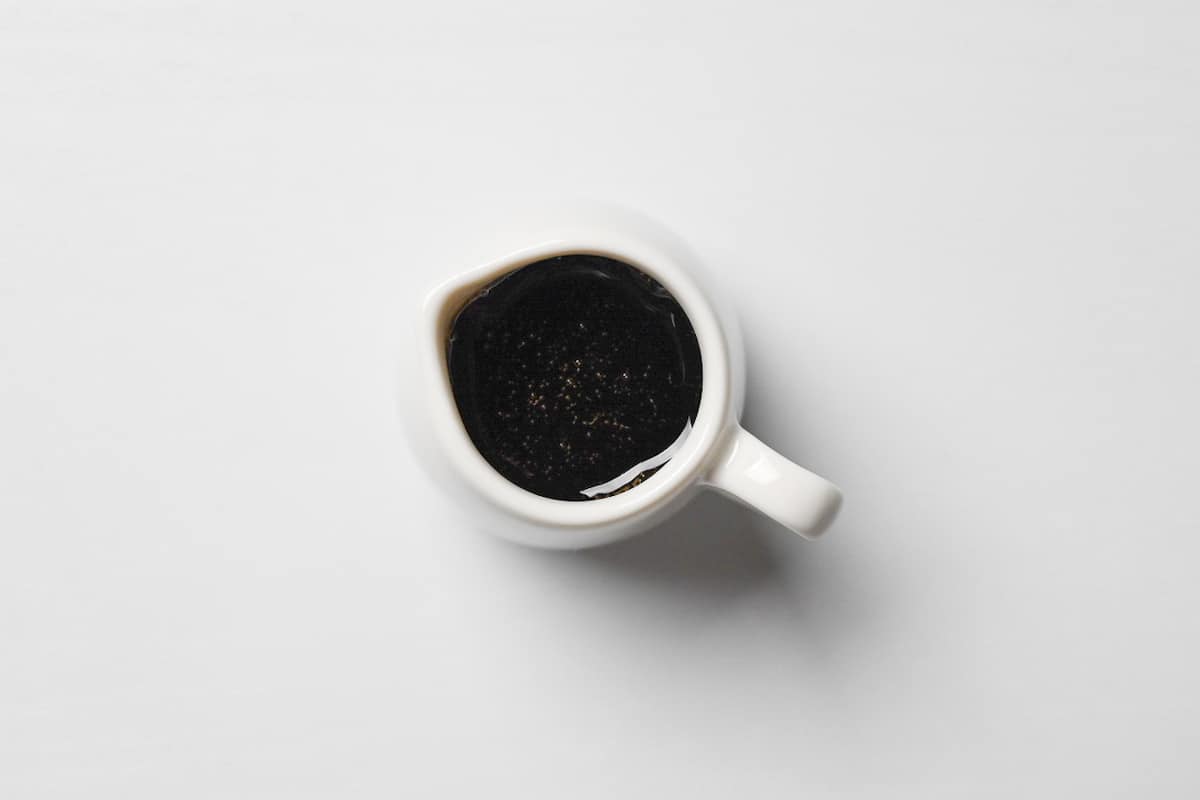
Once 1-2 minutes have passed, remove it from the heat and allow it to cool to room temperature. Once it’s cool, transfer to a serving jug.
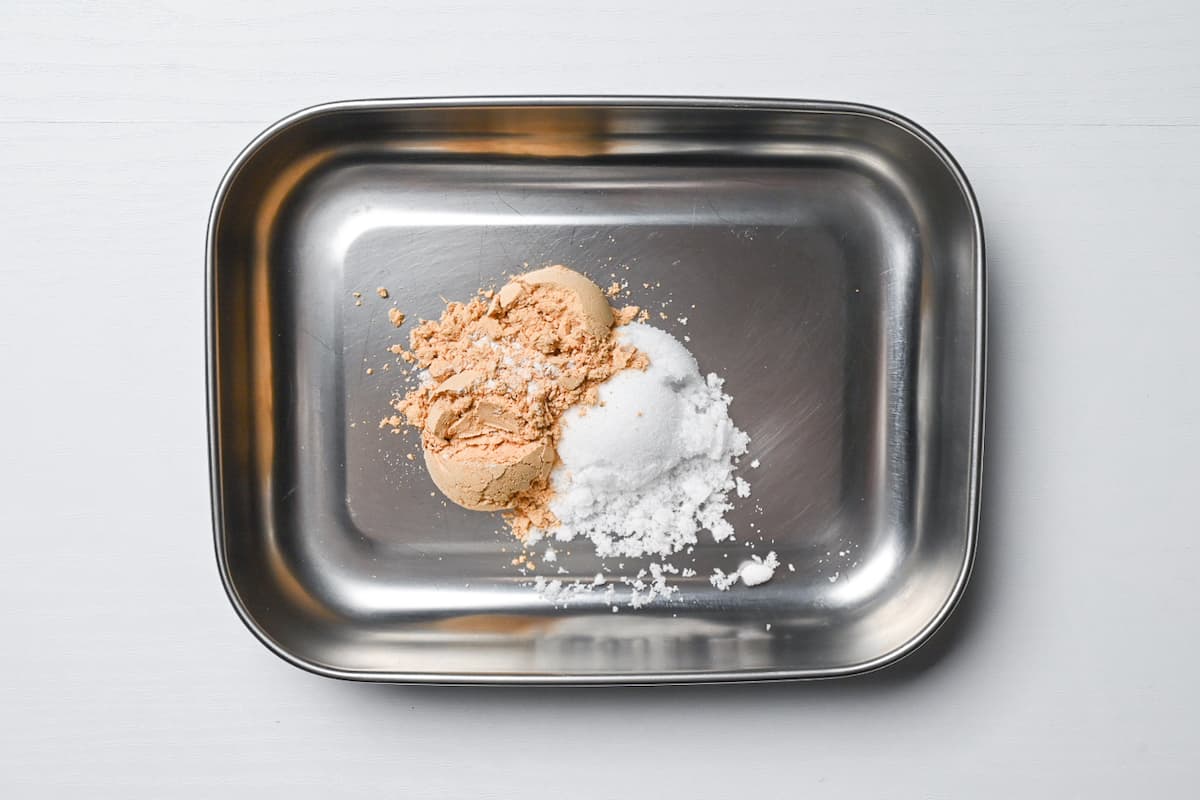
Kinako powder alone doesn’t have any sweetness, it needs to be mixed with sugar and a touch of salt to bring out the best flavor.
Simply mix kinako, sugar, and salt in a container and then you can roll the warabi mochi in the mixture.
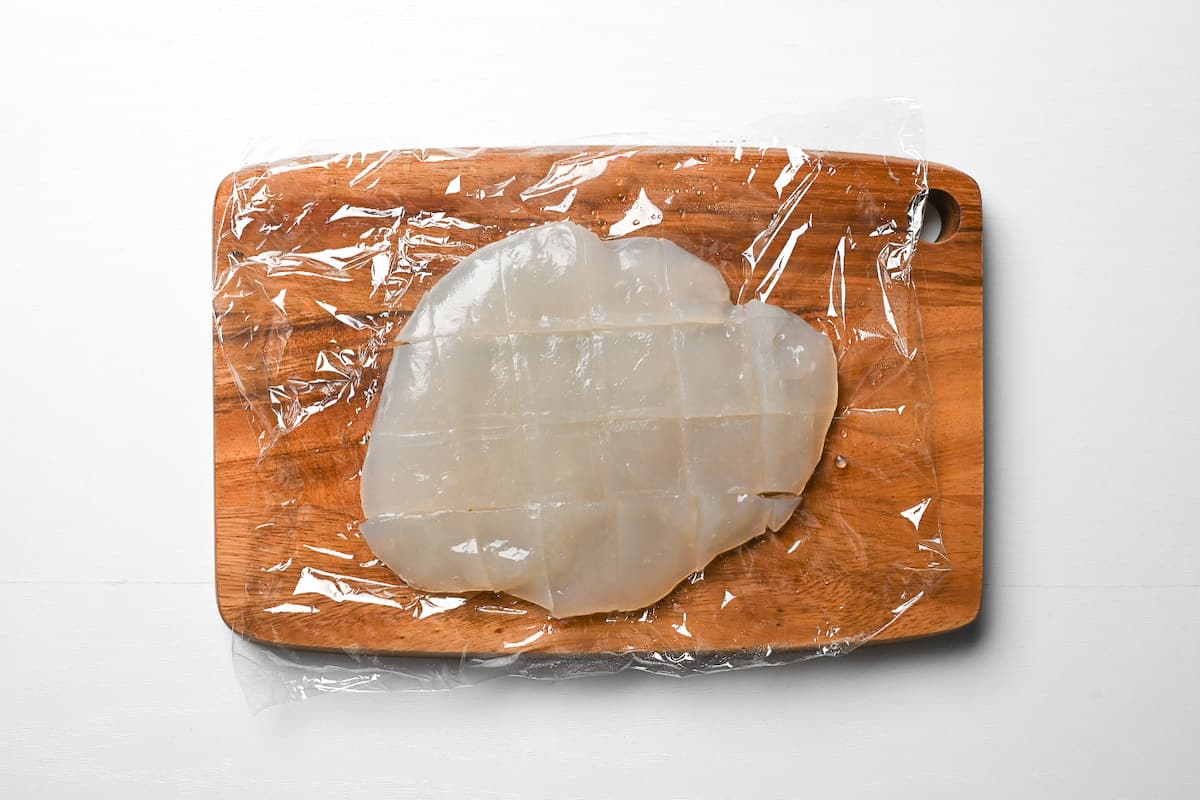
Once the warabi mochi is ready to serve, transfer it to a chopping board and cut it into bitesize pieces.
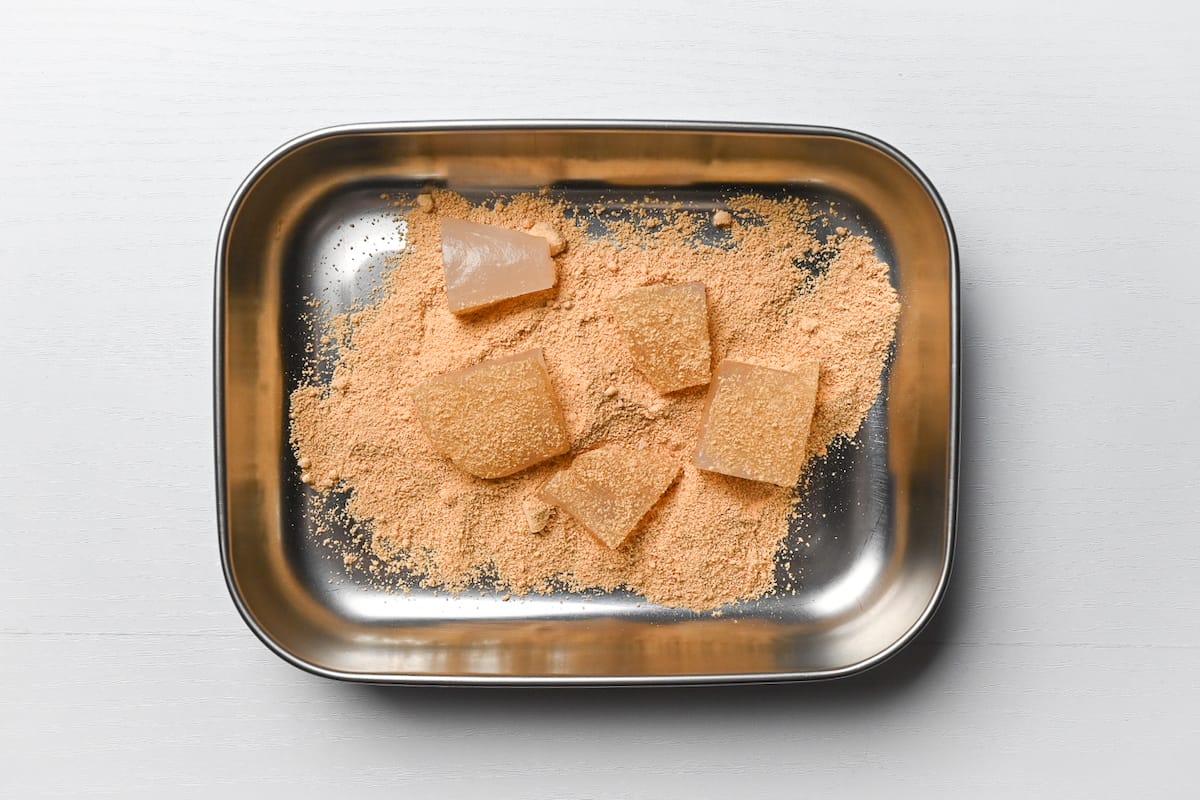
Roll each piece in the kinako powder right before serving.
Flavor Variations
Because warabi mochi is made simply with a mixture of starch, sugar and water, it’s easy to customize it with different powders and flavorings! Here are a few ideas on how you can customize your warabi mochi:
- Matcha (coated with green tea powder)
- Chocolate (coated with cocoa powder)
- Mocha (coffee-flavored warabi mochi coated with cocoa and drizzled with condensed milk)
- Fruits Warabi (made with fruit juices)
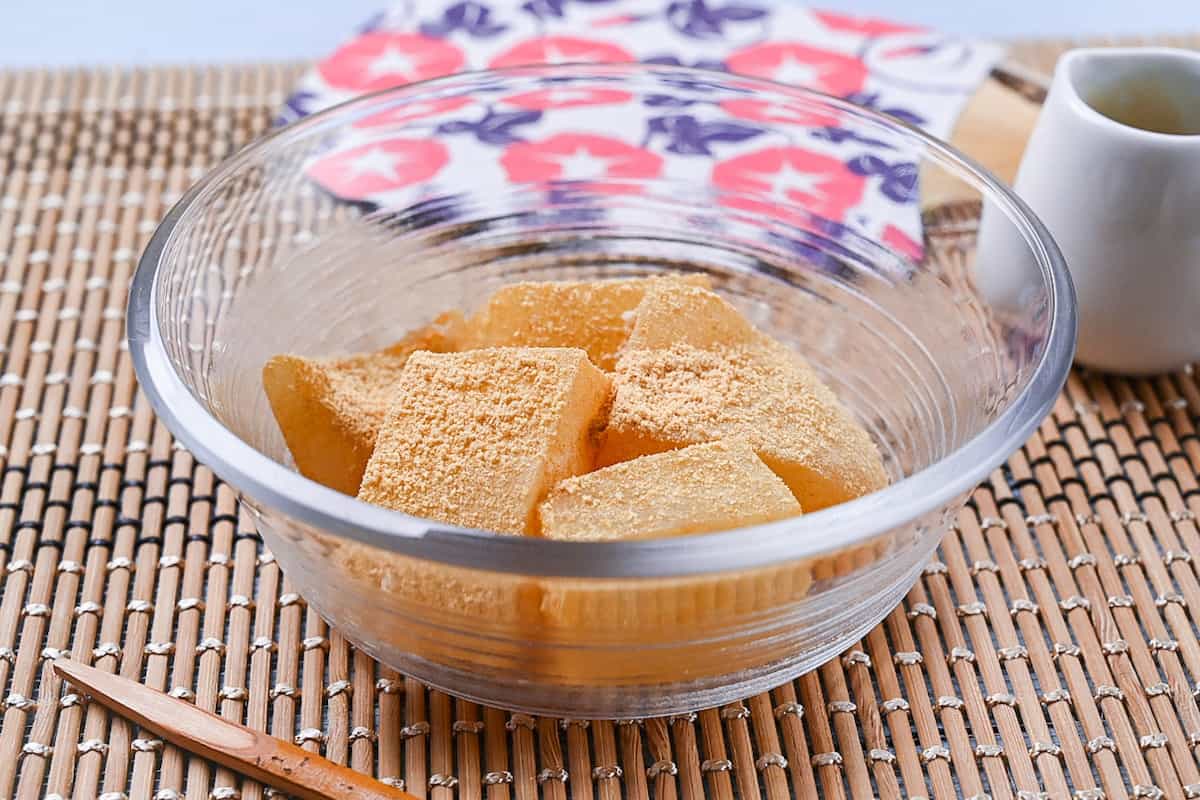
How to Store
Warabi mochi can be stored in an airtight container for 1-2 days. It’s fine to store at room temperature, but I recommend keeping it in a cool dark place away from extreme temperatures.
Prolonged refrigeration can cause the warabi mochi to become hard, but it is recommended to chill for 30 minutes to 1 hour before eating so that you can enjoy it cold.
Make sure to store warabi mochi without the kinako coating. If it is stored with the kinako touching the surface, the powder will become wet, soggy, and fall off. Kinako powder should be stored in a separate container away from moisture and used according to the best-before date stated on the packaging. (It doesn’t need to be refrigerated.)
Warabi mochi is not suitable for freezing.
Storage summary
Room temperature – 1-2 days in an airtight container.
Refrigerated – 2-3 hours.
Frozen – Not suitable.
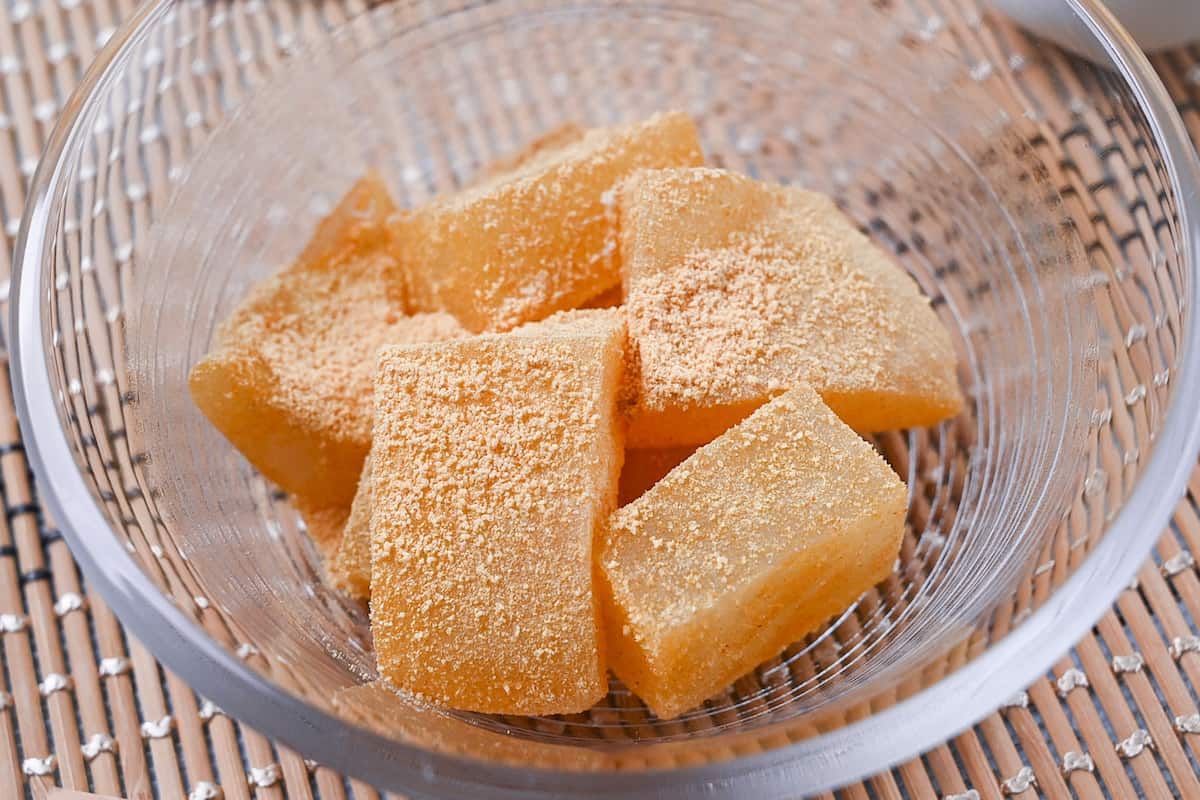
FAQ
Traditionally, warabi mochi is made from bracken starch which comes from the underground roots of a type of fern tree. These days it’s common to make it from potato starch or tapioca starch.
Technically warabi mochi doesn’t have a flavor. The taste comes from the kinako powder (which is nutty) and sugar which adds sweetness. It takes on any flavor that is added and can also be flavored with ingredients like matcha or chocolate.
It can be called “Bracken Cake” in English.
Unfortunately, warabiko can be difficult to find. In Japan, you’ll probably find it in the aisle with the rice flours. Even when I looked online, I couldn’t find any trustworthy place to buy it outside of Japan. Fortunately, I’ve done some research and experiments to find a good substitute and you can read my findings in the article.
Kinako is a powder made by roasting soybeans, removing the skins, and then grinding them into a fine yellow powder. Even the name “kinako” (黄粉) means “yellow flour” in Japanese. The flavor is nutty and a little similar to peanuts.
Warabi mochi is often drizzled with a thick black sugar syrup we call “kuromitsu” which has kanji characters that mean “black honey” (黒蜜). Kuromitsu is very rich and used in many Japanese drinks and desserts. It’s usually made with a type of dark sugar from Okinawa called “kurozato” (also known as “kokuto”), however, this can be substituted with dark muscovado sugar for very similar results.
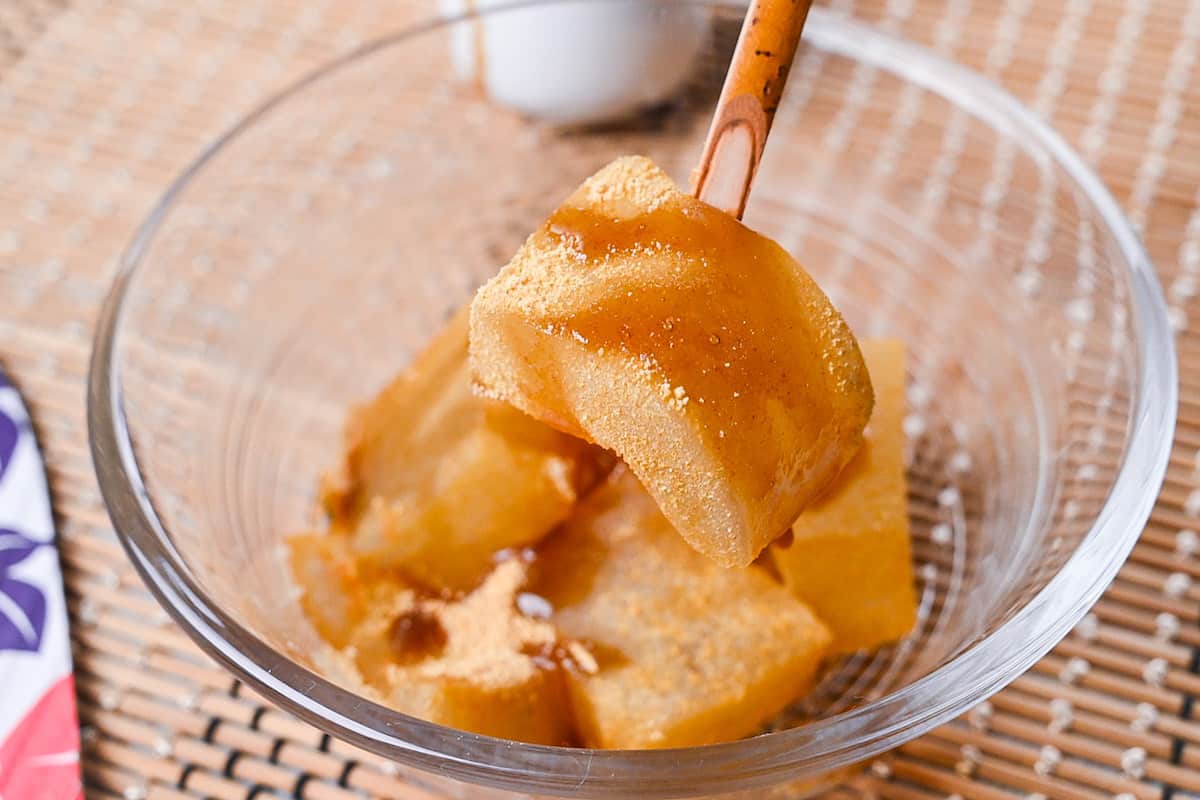
I hope you enjoy this Warabi Mochi recipe! If you try it out, I’d really appreciate it if you could spare a moment to let me know what you thought by giving a review and star rating in the comments below. It’s also helpful to share any adjustments you made to the recipe with our other readers. Thank you!
More Japanese Dessert Recipes
- Silky Japanese Purin
- Ichigo Daifuku (Strawberry Mochi)
- Mizu Yokan (Red Bean Jelly)
Want more inspiration? Explore my Japanese Dessert Roundup Post for a carefully selected collection of tasty recipe ideas to spark your next tea party!
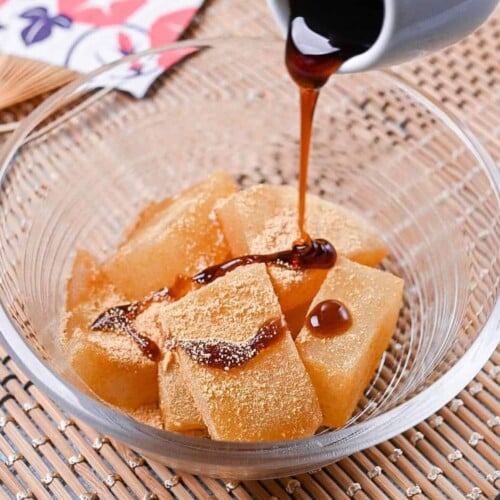
Easy Warabi Mochi (with Homemade Kuromitsu)
Ingredients
Warabi Mochi
- 50 g bracken starch (warabiko) or tapioca starch/potato starch
- 3 tbsp white sugar
- 250 ml water
Kuromitsu (Black sugar syrup)
- 25 g dark brown sugar muscovado or similar
- 25 g white sugar
- 50 ml water
Kinako Powder
- 2 tbsp roasted soybean powder (kinako) (kinako)
- 2 tbsp white sugar
- 1 pinch salt
My recommended brands of ingredients and seasonings can be found in my Japanese pantry guide.
Can’t find certain Japanese ingredients? See my substitution guide here.
Instructions
Warabi Mochi
- Before you start, line a container with plastic wrap and sprinkle a small amount of water over the surface.

- Take a bowl and mix 50 g bracken starch (warabiko) with 3 tbsp white sugar and 250 ml water until smooth.

- Place a sieve over a saucepan and pour the mixture through to remove any lumps of sugar or starch.

- Place the saucepan on the stove and turn on the heat on a medium setting. Stir continuously with a spatula.

- Once the mixture starts to thicken, turn down the heat to low/medium-low and mix continuously.

- The warabi moch is complete when the mixture becomes translucent (there should be no more liquid or white starch showing) and forms a jelly-like ball.

- Remove from the heat and transfer the warabi mochi to the container. Smooth out the top with the spatula. (Dip the spatula in water to prevent sticking.)Allow to cool for 5-10 minutes and then rest in the fridge for 30 minutes to 1 hour.

Kuromitsu
- While the warabi mochi is cooling, make the kuromitsu by adding 25 g dark brown sugar, 25 g white sugar and 50 ml water to a small saucepan and mix well.

- Place the saucepan on the stove and bring to a boil over a medium heat. (Continue to stir to break up any stubborn lumps of sugar.)Once the syrup starts to bubble, turn down the heat to medium-low and simmer for 2-3 minutes. Scoop out any foam that forms around the edges with a spoon.

- Remove the pan from the heat and allow to cool before transferring to a small serving jug.

Kinako Powder
- Add 2 tbsp roasted soybean powder (kinako), 2 tbsp white sugar and 1 pinch salt in a bowl/container. Mix until well incorporated. (Alternatively, you can seal the container and shake until evenly distributed.)

Serving
- Once the warabi mochi is chilled, cut it into squares.

- Place each square into the kinako powder. Roll it around to make sure all of the surface is covered.

- Transfer to serving bowls and drizzle with the homemade kuromitsu syrup.

- Enjoy!
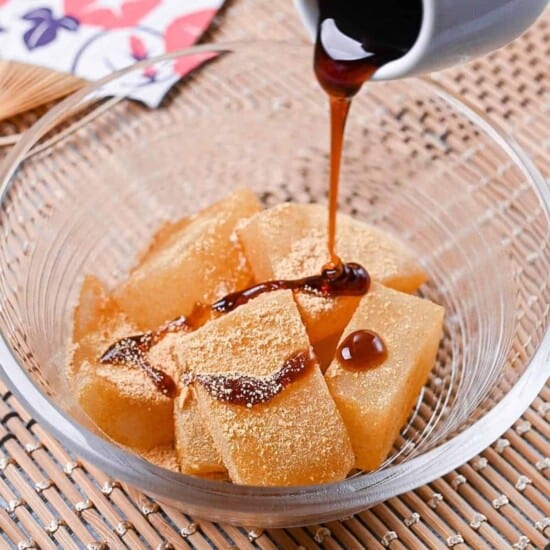




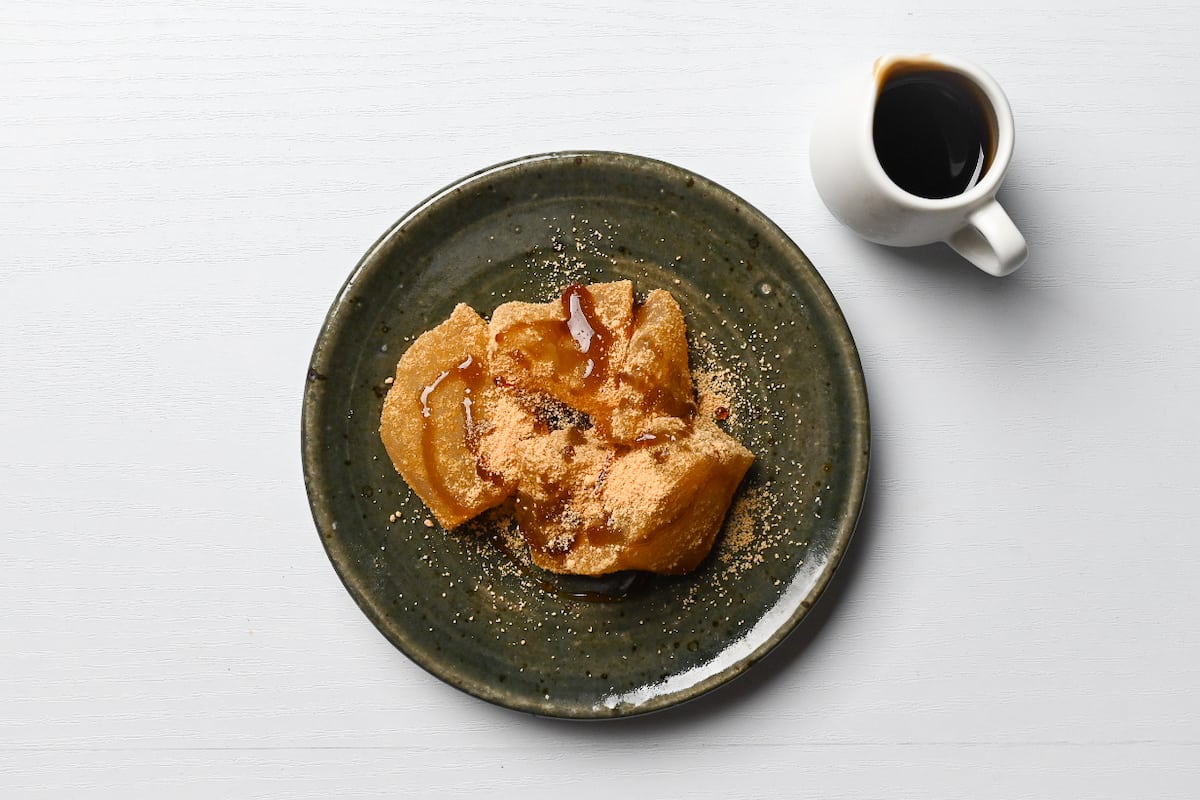
Made this today with norwegian potato starch (I couldn’t find warabiko or katakuriko), but I think it still turned out wonderful. Just such a great texture, and nice simple flavours. Thank you for sharing this recipe. Will make again.
Hi Cathrine,
Thank you for your comment and generous rating, I’m so glad you enjoyed it!
I’ve never seen Norwegian potato starch, it must be similar to katakuriko right? Great to hear that it works!